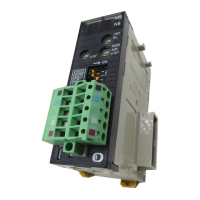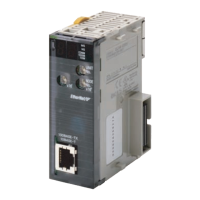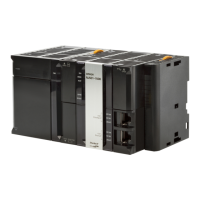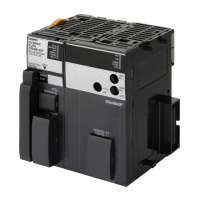3
Fea t ur e s Section 1-1
Triangular Control Triangular control (trapezoidal control without a constant-speed plateau) will
be performed during positioning executed by an ACC(888) instruction (inde-
pendent) or PLS2(887) instruction if the number of output pulses required for
acceleration/deceleration exceeds the specified target pulse Output Amount.
(The number of pulses required for acceleration/deceleration equals the time
required to reach the target frequency x the target frequency.)
Previously, an error would have occurred under these conditions and the
instruction would not have been executed.
Change Target Position
During Positioning
(Multiple Start)
When positioning was started with a PULSE OUTPUT (PLS2(887)) instruction
and the positioning operation is still in progress, another PLS2(887) instruc-
tion can be executed to change the target position, target speed, acceleration
rate, and deceleration rate.
Switch from Speed
Control to Positioning
(Fixed Distance Feed
Interrupt)
A PLS2(887) instruction can be executed during a speed control operation to
change to positioning mode. This feature allows a fixed distance feed interrupt
(moving a specified amount) to be executed when specific conditions occur.
Change Target Speed and
Acceleration/Deceleration
Rate during Acceleration
or Deceleration
When trapezoidal acceleration/deceleration is being executed according to a
pulse output instruction (speed control or positioning), the target speed and
acceleration/deceleration rate can be changed during acceleration or deceler-
ation.
Use Variable Duty Ratio
Pulse Outputs for
Lighting, Power Control,
Etc.
The PULSE WITH VARIABLE DUTY RATIO instruction (PWM(891)) can be
used to output variable duty ratio pulses from the CPU Unit's built-in outputs
for applications such as lighting and power control.
Origin Search
Use a Single Instruction
for Origin Search and
Origin Return Operations
A precise origin search can be executed with one instruction that uses various
I/O signals, such as the Origin Proximity Input Signal, Origin Input Signal,
Positioning Completed Signal, and Error Counter Reset Output.
Also, an origin return operation can be performed to move directly to the
established origin.
Quick-response Inputs
Receive Input Signals
Shorter than the Cycle
Time
With quick-response inputs, inputs to the CPU Unit's built-in inputs (4 inputs
max.) with an input signal width as short as 30
µs can be received reliably
regardless of the cycle time.

